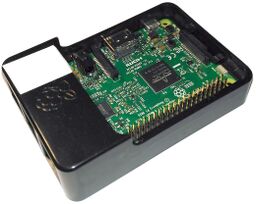NixOS on ARM/Raspberry Pi
The Raspberry Pi family of devices is a series of single-board computers made by the Raspberry Pi Foundation. They are all based on Broadcom System-on-a-chip (SOCs).
Status
Only the Raspberry Pi 3 Family is supported upstream, with the AArch64 effort. Other Raspberry Pis are part of @dezgeg's porting efforts to ARMv6 and ARMv7.
The Linux kernel in use, except for the Raspberry Pi 1 family, is the mainline Linux kernel, and not the Raspberry Pi Foundation's fork. This could reduce compatibility with some add-on boards or third-party libraries[expanded explanation needed].
The following table is intended to be updated by the NixOS contributors with the current status of the boards. For a list of products, see the Products Archive.
| Board name | Architecture | Support |
|---|---|---|
| Raspberry Pi 1 | ||
| Raspberry Pi 1 Model A+ | armv6 | C* |
| Raspberry Pi 1 Model B+ | C | |
| Raspberry Pi Zero | C* | |
| Raspberry Pi Zero W | C* | |
| Raspberry Pi 2 | ||
| Raspberry Pi 2 Model B | armv7 | C* |
| Raspberry Pi 3 | ||
| Raspberry Pi 3 Model B | AArch64 + armv7 |
YES |
| Raspberry Pi 3 Model B+ | YES | |
| Raspberry Pi 3 Model A+ | ? | |
Support
- YES: Supported architecture by Nixpkgs downstream and tested to be working.
- C: Community supported, and tested to be working.
- C*: Community supported, unverified but should be working.
- ? : Unverified, unknown if it will work.
The Raspberry Pi 3 Family is only supported as AArch64. Use as armv7 is community supported.
Board-specific installation notes
First follow the generic installation steps to get the installer image and install using the installation and configuration steps.
Raspberry Pi (1)
The ARMv6 image boots out-of-the-box.
Raspberry Pi 2
The ARMv7 image should boot out-of-the-box, though the author hasn't personally tested this.
Raspberry Pi 3
Both the AArch64 and ARMv7 images boot out-of-the-box. Using the 64-bit AArch64 image is highly recommended, as the availability of binaries is much better and allows the use of the 64-bit instruction set.
Use the following GPIO Pins with an USB-TTL connector:
GND - 3rd in top row, black cable
GPIO 14 TXD - 4th in top row, white cable
GPIO 15 RXD - 5th in top row, green cableUse nix-shell -p screen --run "screen /dev/ttyUSB0 115200" to connect to the console.
force_turbo=1 in /boot/config.txt {
...
hardware.enableRedistributableFirmware = true;
hardware.firmware = [
(pkgs.stdenv.mkDerivation {
name = "broadcom-rpi3-extra";
src = pkgs.fetchurl {
url = "https://raw.githubusercontent.com/RPi-Distro/firmware-nonfree/54bab3d/brcm80211/brcm/brcmfmac43430-sdio.txt";
sha256 = "19bmdd7w0xzybfassn7x4rb30l70vynnw3c80nlapna2k57xwbw7";
};
phases = [ "installPhase" ];
installPhase = ''
mkdir -p $out/lib/firmware/brcm
cp $src $out/lib/firmware/brcm/brcmfmac43430-sdio.txt
'';
})
];
networking.wireless.enable = true;
}
Raspberry Pi 3B+
Here is a similar incantation as above, but for the Raspberry Pi 3B+:
{
...
hardware.enableRedistributableFirmware = true;
hardware.firmware = [
(pkgs.stdenv.mkDerivation {
name = "broadcom-rpi3bplus-extra";
src = pkgs.fetchurl {
url = "https://raw.githubusercontent.com/RPi-Distro/firmware-nonfree/b518de4/brcm/brcmfmac43455-sdio.txt";
sha256 = "0r4bvwkm3fx60bbpwd83zbjganjnffiq1jkaj0h20bwdj9ysawg9";
};
phases = [ "installPhase" ];
installPhase = ''
mkdir -p $out/lib/firmware/brcm
cp $src $out/lib/firmware/brcm/brcmfmac43455-sdio.txt
'';
})
];
networking.wireless.enable = true;
}
Until the kernel 3.18 is finalized, this will require a temporary work-around image. See also the note in the #Serial console section. The workaround is no longer needed:
Serial console
Your configuration.nix will need to add console=ttyS0,115200n8 to the boot.kernelParams configuration to use the serial console.
{ config, pkgs, lib, ... }:
{
boot.kernelParams = [
"console=ttyS0,115200n8"
];
}
Camera
For the camera to work, you will need to add the following code to your configuration.nix:
{ config, pkgs, lib, ... }:
{
boot.loader.raspberryPi.enable = true;
# Set the version depending on your raspberry pi.
boot.loader.raspberryPi.version = 3;
# We need uboot
boot.loader.raspberryPi.uboot.enable = true;
# These two parameters are the important ones to get the
# camera working. These will be appended to /boot/configuration.txt.
boot.loader.raspberryPi.firmwareConfig = ''
start_x=1
gpu_mem=256
'';
}
To make the camera available as v4l device under /dev/video0 the bcm2835-v4l2 kernel module need to be loaded. This can be done by adding the following code to your configuration.nix:
{ config, pkgs, lib, ... }:
{
boot.kernelModules = [ "bcm2835-v4l2" ];
}
Binary Cache
Depending on the architecture used, binary caches availability varies. Binary caches instructions are on the main NixOS on ARM page. The following table desribes the architectures supported by each board.
| Raspberry Pi 1 | armv6 |
|---|---|
| Raspberry Pi 2 | armv7 |
| Raspberry Pi 3 | armv7 |
| AArch64 |
Notes about the boot process
Raspberry Pi (all versions)
USB keyboards and HDMI displays work perfectly.
Using the 3.3v serial port via the pin headers (exact location depends on hardware version) will get u-boot output and, when configured, a Linux kernel console.
Troubleshooting
Power issues
Especially with the power-hungry Raspberry Pi 3, it is important to have a sufficient enough power supply or weirdness may happen. Weirdness may include:
- Lightning bolt on HDMI output "breaking" the display.
- Screen switching back to u-boot text
- Fixable temporarily when power is sufficient by swtiching VT (alt+F2 / alt+F1)
- Random hangs
This problem is a hard problem. It is caused by the Raspberry Pi warning about power issues, but the current drivers (as of
Linux 4.14) have a hard time dealing with it properly. If the power supply is rated properly AND the cable is not incurring too much power losses, it may be required to disable the lightning bolt indicator so the display driver isn't messed up.[1] The lightning bolt indicator can be disabled by adding the line avoid_warnings=1 in config.txt[2]
